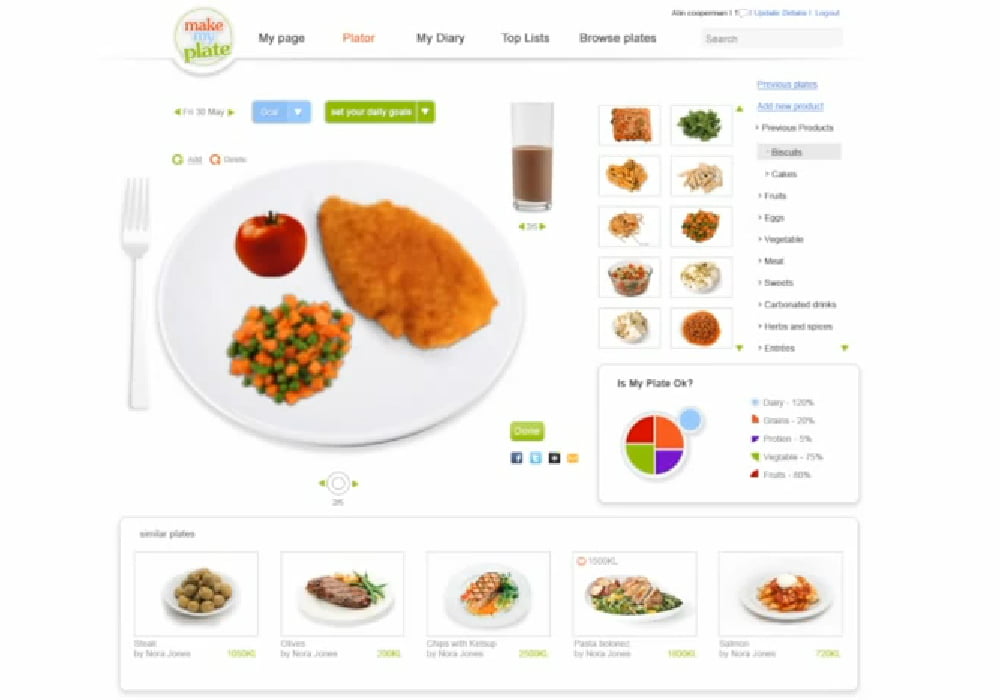Most diets are fads and ones that have proven successful, like WeighWatchers, are tedious (adding and subtracting food points all day is tiring, believe me.) Alin Cooperman, CEO of Make My Plate, is on a mission to make tracking nutrition easier — and way more fun.
Related articles
- Researchers Find Another Healthy Use For Fish Oil: Pain Relief
- Wait, What? Eating Carbs At Night Could Benefit Obese People
During her graduate studies in Jerusalem, Cooperman visited a nutritionist who gave her a food diary to track her caloric intake. “The idea came to me to combine the idea of a food diary with something visual, something that would actually show how I eat,” Cooperman tells NoCamels.
In 2011, Cooperman left her job and studies to start Make My Plate, which she refers to as the “first visual personal nutrition platform.”
The goal of Make My Plate is to make the way people analyze their food intake easier and more fun. “We want to learn about you and then help you make healthy decisions,” Cooperman explains. Users enter the site, and can create a simple profile, or sync an existing Facebook account. They can then get started using the Make My Plate site to make virtual plates of meals, in order to calculate calories, fats, carbohydrates, cholesterol, and protein.
[youtuber youtube=’http://www.youtube.com/watch?v=RKB_cDGV-3g’]
Users drag and drop photos of foods, and can resize them to create a virtual plate that mirrors what they actually ate. The site is then able to calculate caloric intake and nutritional value based on these “plates”. “We have uploaded a ton of pictures of food. People can add new products, and send these photos to us, which we will upload after we have consulted our team of nutritionists about the nutritional values,” says Cooperman. The nutritional values on the site are in accordance with US Department of Agriculture (USDA) standards and practices, she says.
Share your plate
The plates users create are then saved to their online food diary, and can be looked at later on to see nutritional ingestion by day, week, or month. Users can also see what percentage of their recommended daily nutritional intake they have consumed at any point. In the corner of the screen is the new MyPlate icon that is used by the USDA to describe a balanced diet. Users can see which food category each added food item falls under (dairy, vegetables, proteins etc.) These virtual plates can then be shared (by choice) with users on the site, Facebook and Twitter.
“We have created a search engine, where users can search for plates based on ingredients or calories. Users can then find plates made by other users and nutritionists,” says Cooperman. “The main thing is, when people are going on a diet, or have a limiting disease like diabetes or celiac, it’s hard to know what to eat. Now, users can meet people just like them on the site and share food plans,” Cooperman explains.
Sign up for our free weekly newsletter
SubscribeMake My Plate has created an online network, or “marketplace” where users can interact and learn from each other. Within this network, Make My Plate has approved certain nutritionists and clinical dieticians to join the site as advisers. Make My Plate users can message the experts for advice, and even set up video consultations. Each nutritionist sets his or her own price for these video chat sessions, and users can choose with whom to make an appointment. Make My Plate makes a percentage off every session scheduled through the site.
At the moment, Make My Plate is screening the nutrition experts who join the marketplace. “Eventually, we want to open up our marketplace to all nutrition experts, and allow the community to decide who is legitimate and who is not,” Cooperman reports.
Keep track of your diet on the go
The pilot testing of the site was completed in Israel a little over a month ago and the site is now live. Make My Plate has also released an iPhone app, through which users can create visual plates and count calories. A full Android app is also in the works. In addition to monetizing through the online appointments, the company also hopes to monetize with advertising.
Big in Australia
Make My Plate plans to target English-speaking countries including Canada, the US, UK, and Australia. The site has already garnered good traffic from Australia after an article was published in an Australian Dietitian Association publication. The company is also looking for ways to become a nutrition-teaching tool for children in schools.
Make My Plate has competition from a number of other online calorie-counter and diet websites, but believes they are different because they “show nutrition in a visual way.” So far, the company has thousands of people using the site, and reports that many users are joining every day. The company received an undisclosed amount of pre-seed money from angel investors, and is now in the midst of another round of funding.
CEO Alin Cooperman holds an undergraduate degree in psychology from Ben Gurion University, and has put her graduate degree at Hebrew University on hold to develop Make My Plate. Along with Cooperman, the company’s developer, design team, and advisory board are all based in Israel.
Photo by Make My Plate
Related posts

Israeli Medical Technologies That Could Change The World

Harnessing Our Own Bodies For Side Effect-Free Weight Loss

Missing Protein Could Unlock Treatment For Aggressive Lung Cancer




Facebook comments